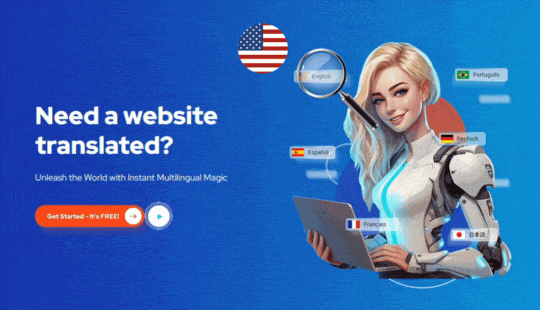
The process of website translation gives even translation agencies some trouble. Despite being something they do for a living, the same struggles apply to their process.
The process used to be more lengthy before computer translation was developed (for example, plugins like ConveyThis) and made available to the general public. So in terms of advantages, the only one translation agencies held over other businesses was that they were one step ahead financially, but the time needed to complete the project was the same.
A human translator has their limits, it doesn’t matter if they are doing outsourced work or working for their own agency. A translator can only work about 8 hours a day and the amount of words they can translate in a day, in order to produce quality work, is rather limited.
Nowadays, after all the research and experimentation done with automatic translation, these tools have become incredibly efficient. These automatic translation services work at unimaginable speeds and don’t require rest. For example, Google Translate, one of the most famous examples, can translate more than 100 billion words in a day.
Regarding translation speed, we have a clear winner, but can a machine beat a human in terms of quality?
With constant innovation in machine learning, machine translation is becoming a more valid alternative. With the Neural Machine Translation System, unveiled in 2016, now computers translate by the sentence, instead of by the word.
Despite this reputation-changing leap, the technology is still prone to making mistakes that a human translator would never make, especially if the text is long and complex.
Even if the text is simple and the machine translates it “correctly”, it may ring tonally deaf and not fit your brand’s personality or not sound compelling enough.
But this doesn’t mean that the human vs machine rivalry is still on and only one side can win.
ConveyThis: a multilingual website
At ConveyThis we put our money where our mouth is and have used our own translation AI to turn our website into our multilingual one.
The website was made in the USA by Translation Services USA but we work with companies all over the world and we want to show them how welcome they are by providing content in their language. Therefore, our website features several language options, so far we have: Japanese, Chinese, Spanish, French, Russian, and English (our base version).
Testing
First of all, we used our plugin translation tool to translate every single instance of text it could find. This was a great opportunity to further test our AI and learn more about how neural networks make associations and learn, this also tells us where and what to tweak to improve the tool. We had the whole team take a look and make notes and comments.
For this phase we would pick a new language for the plugin to translate, the computer finished the project in a minute, and then we gave the results to those team members who were the language’s native speakers to get trusty feedback. They were pleased with the results, but they said some small tweaks wouldn’t harm, after all, we are trying to sell our service and computers aren’t good at sales pitches.
Assessment
This phase is important for us to understand the limits of machine translation and know how involved human translators and editors should be in the process. There’s a perfect balance to be struck and we want to discover where it is.
For this phase we had to filter all the pages and keep only those with format issues and those that needed some fixes regarding the wording. For the rest, we trusted the automated translation results, no need to have an expert look at something that’s good!
There’s nothing as tedious as having to correct a repeated mistake, and the great thing about ConveyThis, is that it’s able to apply any corrections made to one statement to all other instances of a phrase on the website, definitely a time saving solution!
When it came to correcting we had two options, to outsource or to correct it ourselves, the decision ultimately depended on the topic and complexity of the text.
Outsourcing
For the work we decided to outsource, we created glossaries for the translators to use. These are necessary elements because every company has preferences for certain terminology and how to translate those new words that the tech world churns out daily.
As in the case with the word “app”, it stems from an existing word, application, so giving a common word an additional meaning for it to be used in a new context has always been a popular resource, but this may confuse automatic translators and have them misinterpret the context.
Context interpretation has always been a problem for automatic translations. When it comes to words with multiple meanings, the risk of a mistranslation will always be higher.
Therefore, preferred translations for company specific terms need to be added to databases and glossaries for humans and for machines, too!
Sometimes we may use different terms for the same thing, and if the translation also features more than one option, we should check them all. If we prefer, we can choose only one option and have that set as a unified correct translation.
We also checked if company names were not accidentally translated, this happens when names or very technical terms are made up of recognizable nouns. Since we don’t want them to be translated because they are brands, we added the exceptions to the glossary.
And now we had our finished glossary for our translators to work with, knowing how to translate certain vocabulary and phrases, and what to leave untranslated.
Fixing the voice
Online businesses rely on online communication for a living, regardless of what kind of commerce you own. Through text is how everyone communicate with visitors and users, the wording choice needs to be very careful if you are working on your international market presence.
It will be necessary for translators to make sure that the text reflects the brand’s identity, that way the content across all languages will be consistent and coherent. With our brand voice guideline to gain control over the way our message is communicated, we will provide lots of examples by listing what to avoid and preferred alternatives.
After we ordered the translations, we received the finished work in a few days, despite being a very large project (about 25,000 words). You may be thinking that the math doesn’t add up and wondering how many translators worked on it. But remember, these small group of people were not working from scratch on our website, they had a “draft” translation that they had to polish with the help of the glossaries and guidelines we had sent.
Due to the bilingual nature of the project, we needed translators to work on it, but it was mainly an editing and adaptation job, the machine translation didn’t sound very natural or human at times.
Conclusion
Our last step, conclusion. After walking a mile in our client’s shoes, and going over every step of the process feeling very emotionally involved in the results, what did we learn?
It was a huge learning process and a great perspective on the work we do. The process has many layers and requires a lot of effort, and the translation AI has evolved a lot since its humble beginnings back in 1954, the work isn’t over, but we are very excited about the results we are getting.
It’s always a great experience to add a new language, and we are excited for the next one. Overcoming the rivalry between machine and human translation has been a great breakthrough for the industry, there is no need to pick sides, and the balance gives the best results in the least amount of time.
We consider that human editors and translators working on an automatic translation:
- Can do the work faster and give high quality results;
- Is a simplified way of doing the work, (we ordered the translation straight from our dashboard!);
- Is reassuring, because even with only the machine translation up on the site, our visitors did not get confused or lost; and
- Is the optimal way, the results are overwhelmingly positive and time was used efficiently.
Now that we were offering our visitors content in their language, our conversion rates increased! Another reason for the new traffic was our website design, check out this article if you are also looking to improve the user experience on your website.
The website translation process is fast, simple and cheap with ConveyThis. As we mentioned before, we are professionals in the website translation business, and balance machine and human translations to get effective and efficient results, contact us if you are looking for expert localization work!

